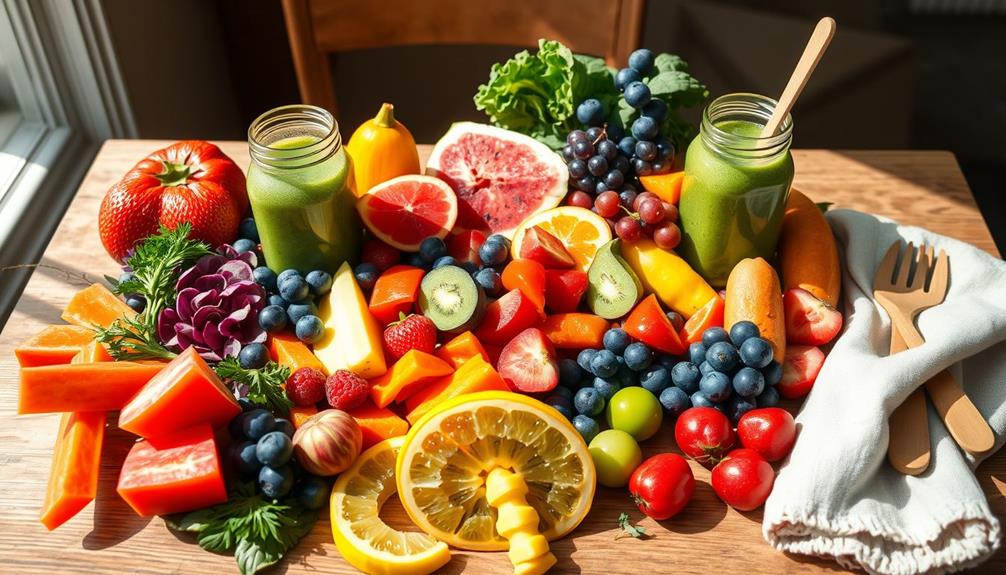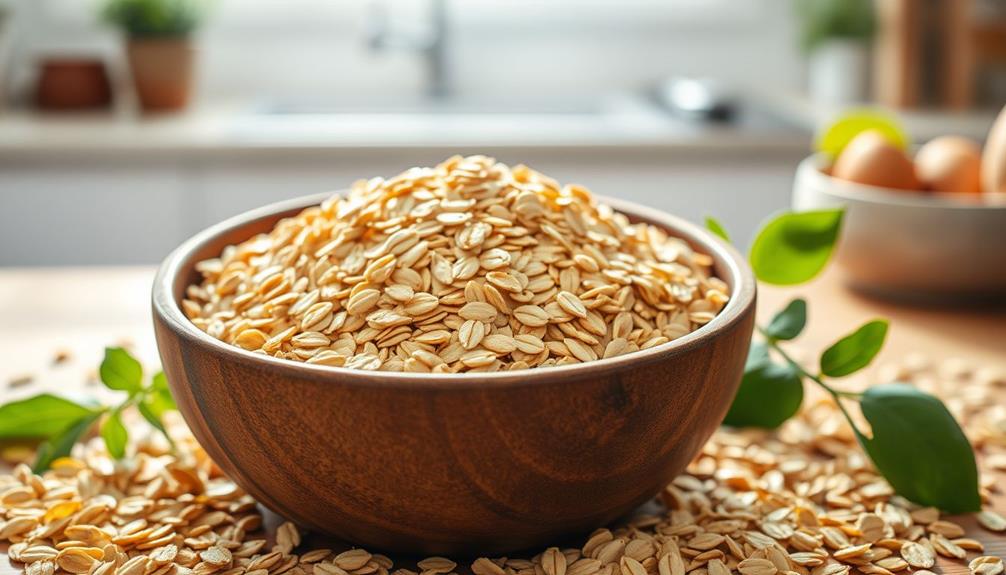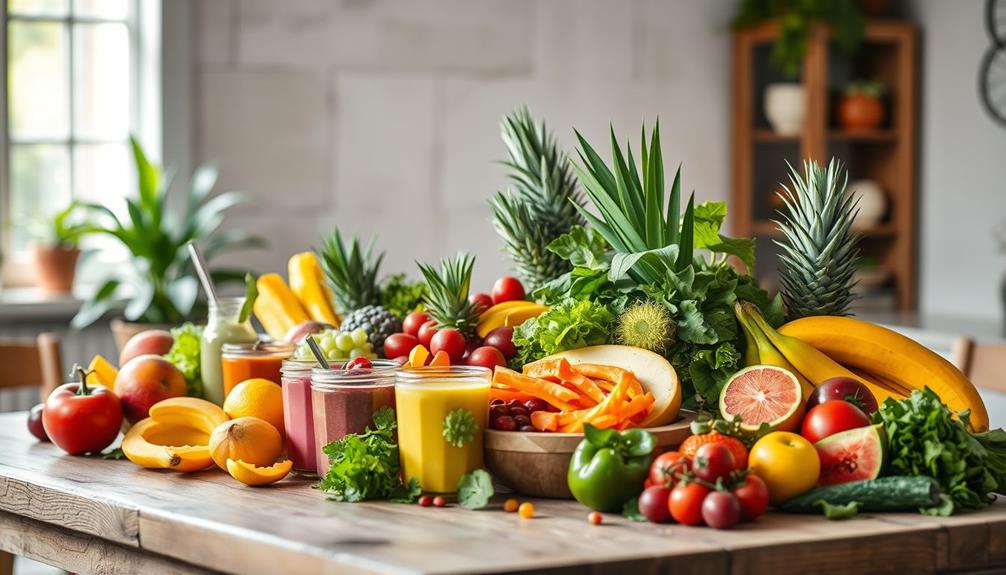To start a raw food diet, focus on unprocessed foods like fresh fruits, veggies, nuts, and seeds. Aim for meals that don't exceed 104-118°F to preserve nutrients. Get creative with preparation methods like blending, juicing, and sprouting. Plan your meals for balance, incorporating smoothies, salads, and raw soups. Gradually increase your raw food intake to ease the shift; beginning with 25% raw foods can help. Remember to include a variety of colorful produce and consider supplements for nutrients like B12. There's a lot more to explore, so keep going to uncover additional tips and tricks for your journey. For some people, transitioning to a raw food diet can be challenging, so don’t be too hard on yourself if you have setbacks. Look for support from online communities or local raw food groups to stay motivated and exchange raw food diet tips. Experiment with different flavors and textures to keep your meals interesting and satisfying. And most importantly, listen to your body and make adjustments as needed to ensure you’re getting the nutrients you need.
Key Takeaways
- Focus on unprocessed, whole foods like fruits, vegetables, nuts, and seeds, ensuring they remain below 104-118°F to preserve nutrients.
- Plan meals to include a variety of seasonal produce, aiming for balance with smoothies, salads, and raw soups.
- Gradually transition to a raw food diet, starting with 25% raw foods and increasing to 75% over time for easier adaptation.
- Utilize preparation techniques like soaking, sprouting, and dehydrating to enhance flavors and nutritional value of raw meals.
- Monitor nutrient intake carefully, considering supplementation for protein and vitamin B12 to avoid deficiencies.
Understanding the Raw Food Diet
The Raw Food Diet emphasizes consuming unprocessed, whole foods like fruits, vegetables, nuts, and seeds. This diet requires that foods not be heated above 104-118°F (40-48°C) to preserve their nutrients and enzymes.
You'll find that preparation methods such as juicing, blending, dehydrating, soaking, and sprouting help maintain the integrity and nutrient content of your meals. Adopting a raw food diet can enhance your nutrient absorption and support digestive health due to its high fiber content, which is vital for overall wellness benefits of raw food.
While some followers include raw animal products like eggs and fish, others strictly adhere to a plant-based approach known as raw veganism. To thrive on a raw food diet, it's important to focus on a high intake of fruits and vegetables, which are rich in nutrients and fiber.
However, balance is significant; without a varied diet, you might face nutrient deficiencies, particularly in protein and vitamin B12. Careful planning and potential supplementation can help you avoid these pitfalls.
Understanding the raw food diet's principles will empower you to make informed choices. By incorporating diverse unprocessed foods and using creative preparation methods, you can enjoy a nutritious, satisfying diet while reaping its many health benefits.
Health Benefits of Raw Foods
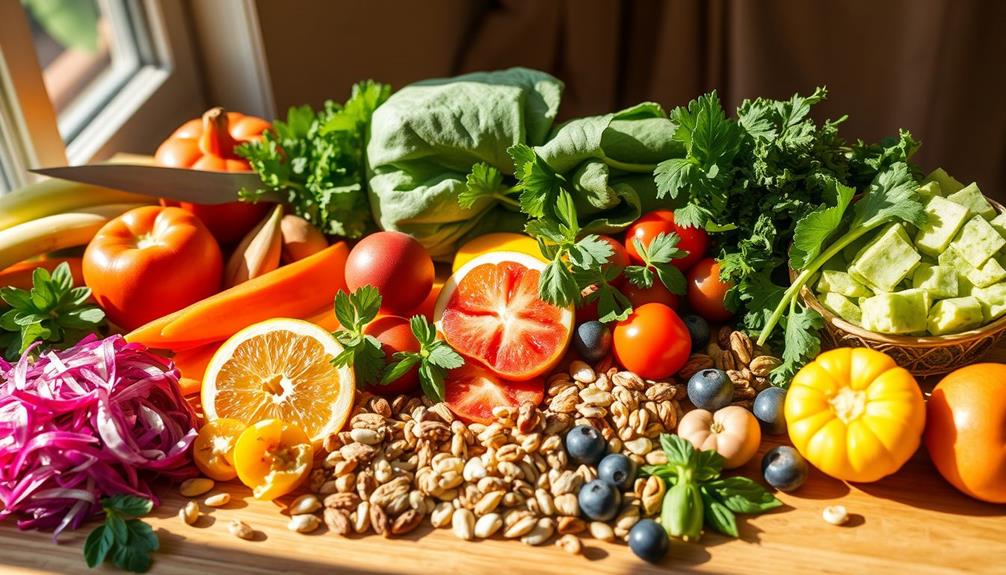
Raw foods offer a wealth of health benefits that can enhance your well-being and energy. Adopting a raw food diet means you're not just eating fruits and vegetables; you're also boosting your nutrient intake and fiber, which improves digestion and supports overall health. This can help reduce the risk of chronic diseases, including heart disease and type 2 diabetes.
Key Health Benefits of Raw Foods
| Benefit | Description |
|---|---|
| Heart Health | Lower blood pressure due to low sodium and high potassium. |
| Digestion | Natural enzymes aid digestion and nutrient absorption. |
| Weight Management | Low-calorie foods promote satiety with fewer calories. |
Additionally, raw foods are packed with antioxidants that contribute to improved energy levels and skin health. The high fiber content not only supports digestion but also plays a crucial role in weight management. By incorporating more raw fruits and vegetables into your diet, you'll be taking significant steps toward a healthier lifestyle. Enjoy the liveliness that comes with embracing raw foods!
Common Challenges and Solutions

Adopting a raw food diet can bring several challenges that might catch you off guard, but recognizing them is the first step to overcoming them. One of the common challenges you'll face is limited food options, especially when dining out, as many restaurants lack suitable meals. This can be frustrating, so consider preparing meals at home to guarantee you have nutritious options available.
Additionally, incorporating ingredients like fresh herbs can enhance flavor and nutritional value, making your meals more enjoyable. For example, using essential oils for hair growth in your raw food preparations can add a unique twist to your dishes.
During the initial change, you might also experience digestive discomfort due to the higher fiber intake. This is normal, but easing into the diet can help your body adjust more smoothly.
Feelings of monotony can arise from the restrictive nature of the diet, impacting your long-term adherence. To combat this, focus on meal variety by experimenting with different raw recipes and ingredients.
Social situations can be tricky, as traditional meals often don't align with your choices, leaving you feeling isolated. Communicate your dietary preferences ahead of time, or bring a dish to share.
Lastly, meal preparation can be time-consuming, but investing in tools like a high-speed blender and food dehydrator can streamline your process and enhance meal variety.
Meal Planning and Preparation
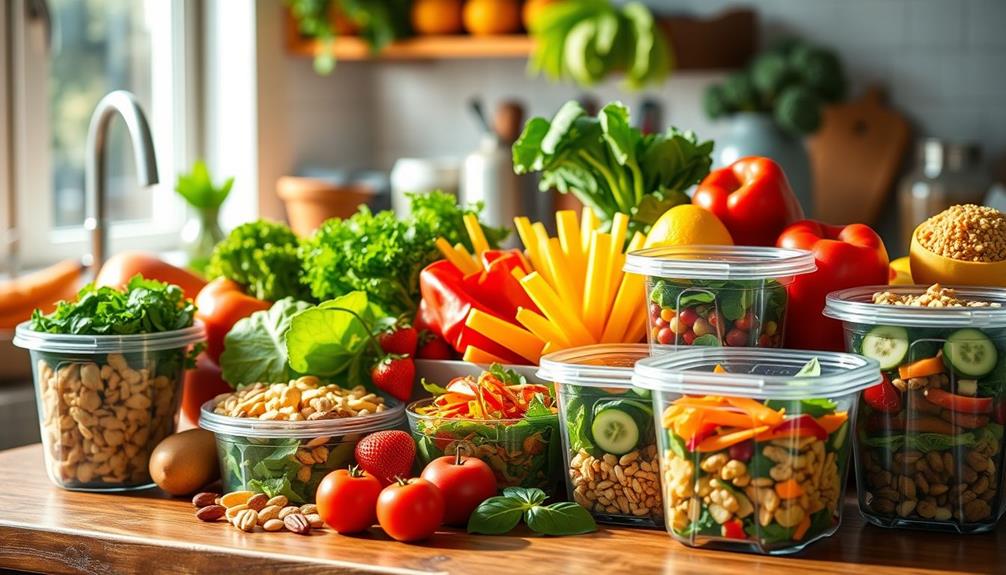
Meal planning and preparation play a significant role in successfully following a raw food diet. To guarantee you're getting a balanced intake of essential nutrients, aim to include a variety of fruits, vegetables, nuts, seeds, and sprouted grains in your meals.
Consider incorporating natural remedies alongside conventional options to enhance your raw food experience. Use effective preparation techniques like soaking, sprouting, dehydrating, and blending to enhance flavor and digestibility while keeping temperatures below 118°F.
Start by creating a weekly meal plan that features diverse options such as smoothies, salads, raw soups, and snacks. Focus on seasonal and local produce for the best freshness and taste. Investing in quality kitchen equipment, such as a high-speed blender and a food dehydrator, can greatly simplify your meal prep and help maintain the integrity of your raw ingredients.
Consider batch prepping items like nut milk, energy bars, and raw dips. This not only streamlines your weekly meals but also reduces food waste and guarantees you have convenient options on hand.
With thoughtful meal planning and preparation, you'll find it easier to stick to your raw food diet and enjoy the full benefits of this vibrant lifestyle.
Essential Foods to Include
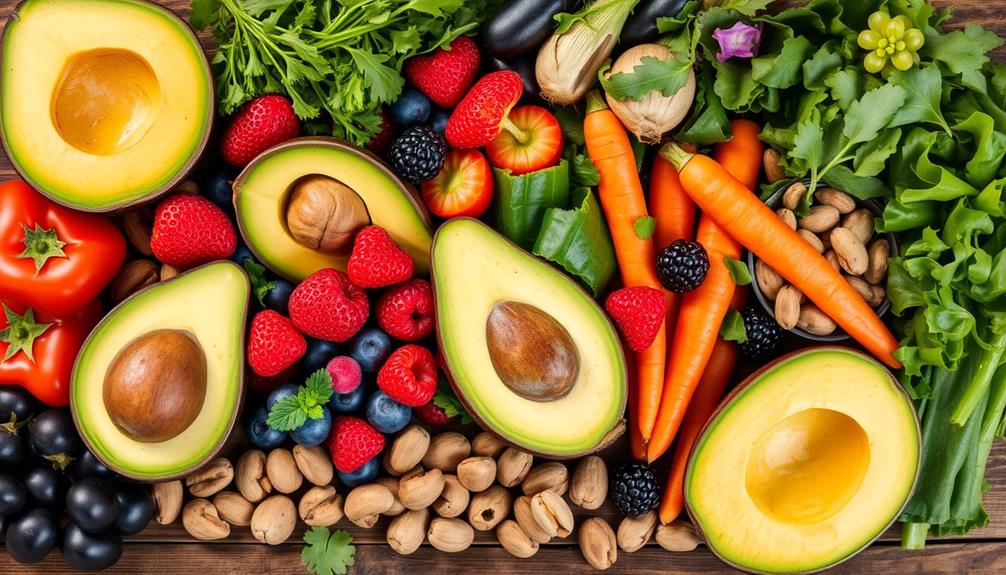
When you're following a raw food diet, it's important to include a variety of essential foods. Fresh fruits, leafy greens, and nutrient-rich nuts and seeds not only enhance your meals but also provide essential vitamins and minerals.
Incorporating foods like celery juice, known for its high levels of antioxidants and anti-inflammatory properties, can further boost your health.
Key Raw Ingredients
A raw food diet thrives on a variety of essential ingredients that pack a nutritional punch. By incorporating these key components, you'll enhance your meals and boost your health. Understanding the importance of different brewing methods can also inspire creative ways to enjoy raw ingredients, such as using fresh fruits in smoothies or salads.
- Fruits: Fresh fruits like apples and bananas not only provide natural sweetness but also deliver fiber for digestion. They're perfect for on-the-go snacks.
- Leafy Greens: Vegetables such as kale, spinach, and cucumbers are vital for their nutrient density. They're rich in vitamins A, C, and K, plus they keep you hydrated.
- Nuts and Seeds: Raw almonds and chia seeds are excellent sources of healthy fats, protein, and minerals. They help guarantee you get essential nutrients and keep you feeling full.
- Sprouted Grains and Legumes: Options like quinoa and sprouted lentils improve digestibility and nutrient availability, enhancing your protein intake.
Don't forget to include fermented foods like raw sauerkraut and kimchi to add probiotics to your diet. These support gut health and digestion, making your raw food diet even more beneficial.
Nutrient-Rich Foods
Nutrient-rich foods are the cornerstone of a successful raw food diet, providing the essential vitamins and minerals your body craves. Start by incorporating a variety of colorful fruits, like berries, apples, and bananas. These fruits are packed with antioxidants, vitamins, and minerals that support overall health.
Additionally, you can enhance your meals with quality fats like butter, which is a source of vitamins A, D, E, and K, contributing to overall wellness butter's health benefits.
Next, don't forget leafy greens such as spinach, kale, and Swiss chard. They're excellent sources of calcium, iron, and vitamin K, all essential for bone health and proper blood clotting.
Adding nuts and seeds, like almonds and chia seeds, can greatly boost your intake of healthy fats, protein, and omega-3 fatty acids, which are crucial for heart and brain health.
You should also consider including sprouted grains and legumes, such as quinoa and lentils. The sprouting process enhances protein content and improves nutrient absorption.
Tips for Successful Transition
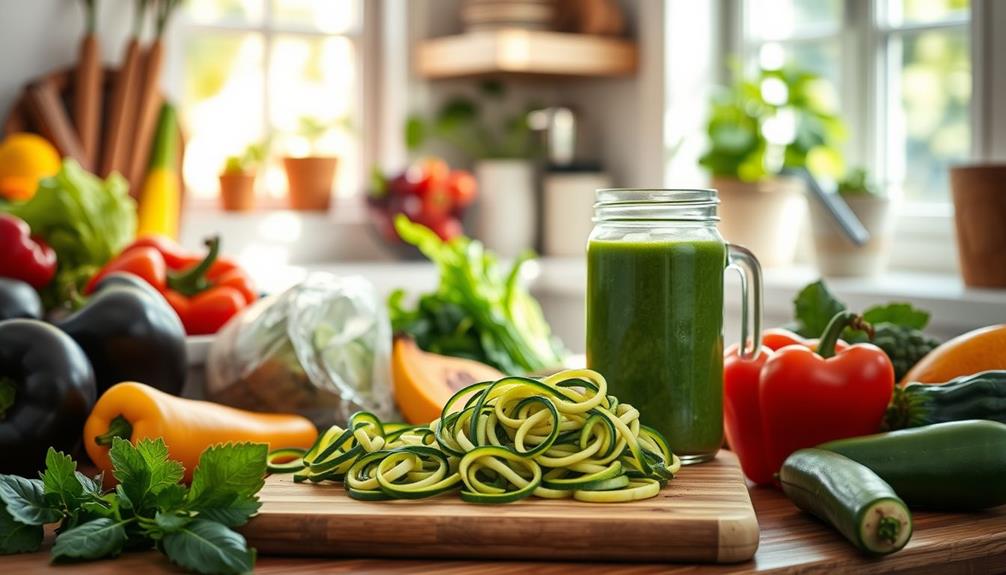
Many people find that changing to a raw food diet can be smoother and more enjoyable with a few strategic steps. Incorporating a balanced approach that includes a variety of fruits and vegetables is essential for ideal health, as seen in the principles of lifestyle for longevity.
Here are some tips to help you during your shift:
- Start Gradually: Begin by incorporating at least 25% raw foods into your meals. This will help you ease into a diet that emphasizes 75% raw foods.
- Keep It Simple: Focus on easy-to-prepare recipes like smoothies and salads. These can make your meals exciting and less overwhelming as you adjust.
- Invest in Tools: Essential kitchen gadgets like a high-speed blender and a food processor are vital for preparing a variety of raw dishes while maintaining temperature limits.
- Monitor Nutrient Balance: Include a variety of fruits, vegetables, nuts, and seeds in your diet, and consider supplementation for nutrients often lacking in raw diets, such as vitamin B12 and omega-3 fatty acids.
Don't forget to seek out support! Joining online communities or local groups can provide recipe ideas, motivation, and encouragement as you navigate your raw food diet shift.
Frequently Asked Questions
How Do You Succeed on a Raw Food Diet?
To succeed on a raw food diet, you should gradually introduce raw foods, invest in essential kitchen tools, focus on diverse ingredients, plan meals, and engage with supportive communities for motivation and recipe sharing.
How to Eat on a Raw Food Diet?
Eating on a raw food diet's like upgrading your smartphone to the latest version—fresh, vibrant, and full of potential. You'll focus on fruits, veggies, nuts, and seeds, mixing flavors to keep meals exciting and nutritious.
How Do You Get Full on a Raw Diet?
To get full on a raw diet, focus on high-fiber foods like leafy greens and fruits. Incorporate calorie-dense options such as nuts and healthy fats, while staying hydrated to manage hunger effectively. Enjoy your meals!
How to Start a Raw Diet for Humans?
Did you know that over 90% of raw food dieters report increased energy levels? To start your raw diet, gradually add raw fruits, veggies, nuts, and seeds, and invest in essential kitchen tools for easy meal prep.
Conclusion
Embracing a raw food diet can be an invigorating journey, like adding vibrant colors to a dull canvas. By understanding the benefits, tackling challenges, and planning your meals, you'll find your way to a healthier lifestyle. Remember, patience is key as you shift; let your taste buds guide you. With essential foods in your pantry and a sprinkle of creativity, you'll savor the vibrant flavors of raw eating, nourishing both your body and spirit.

